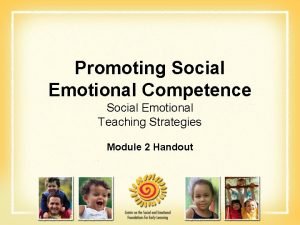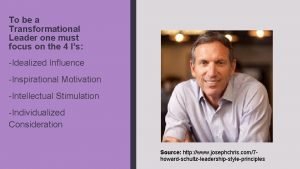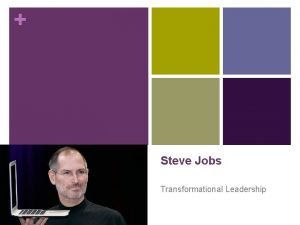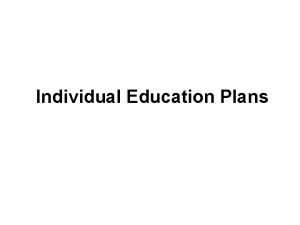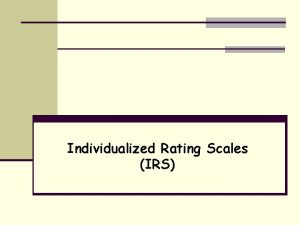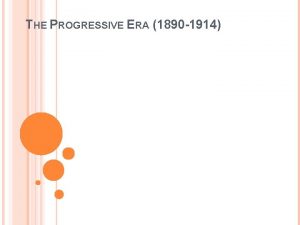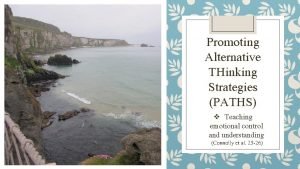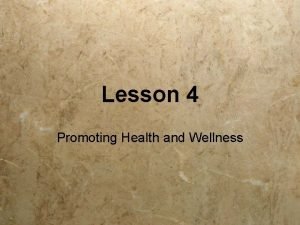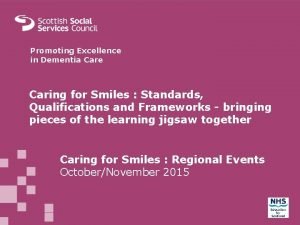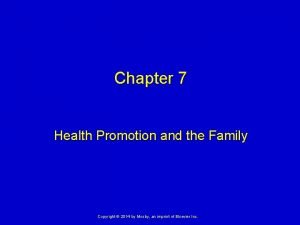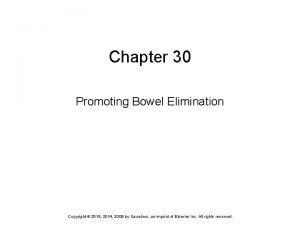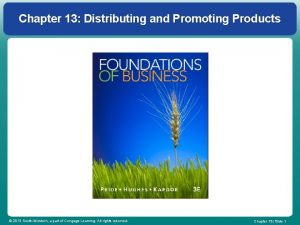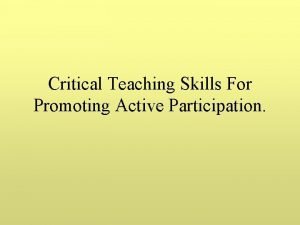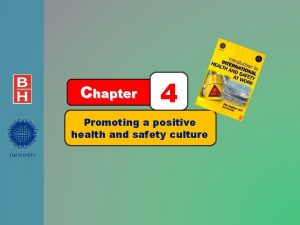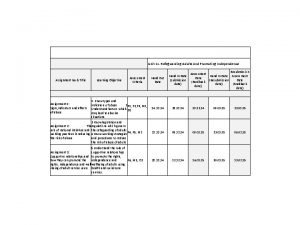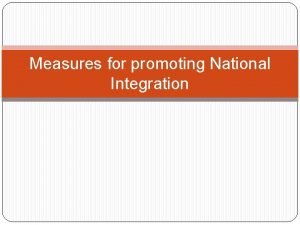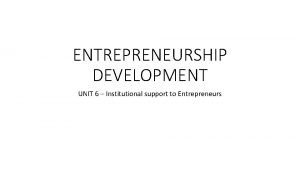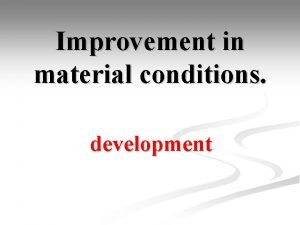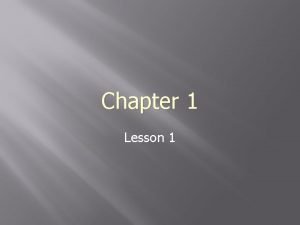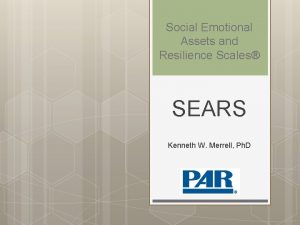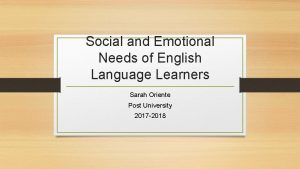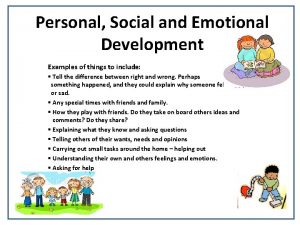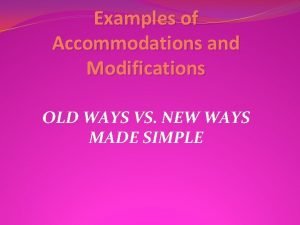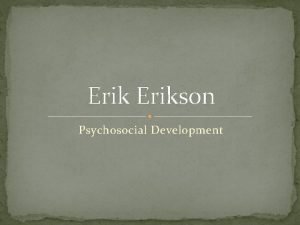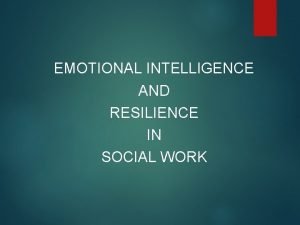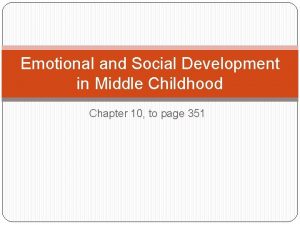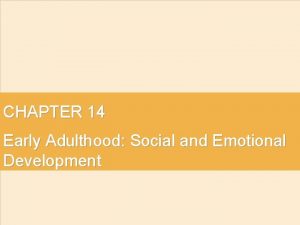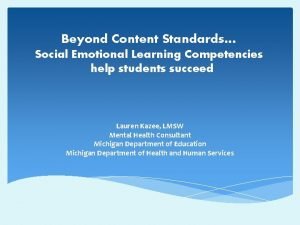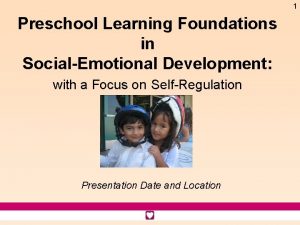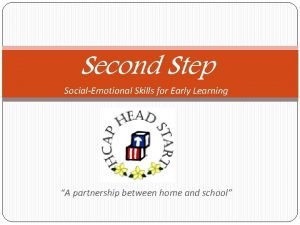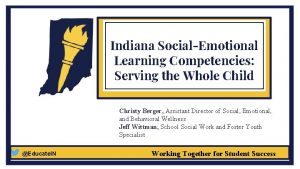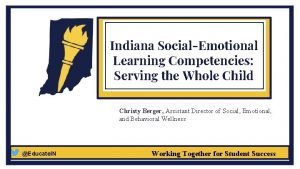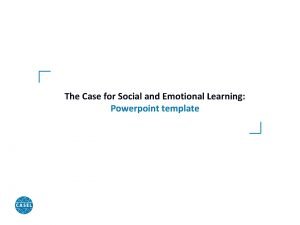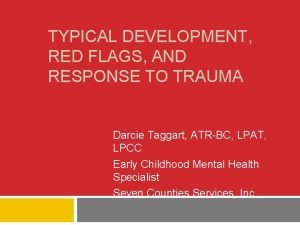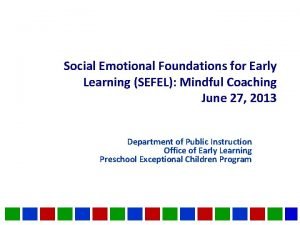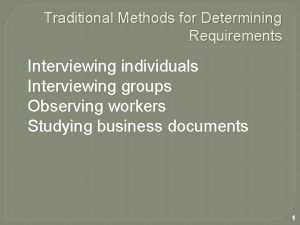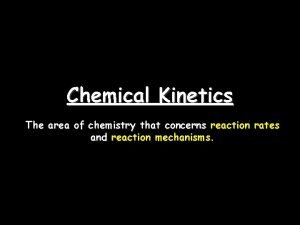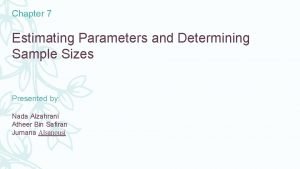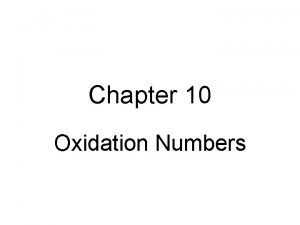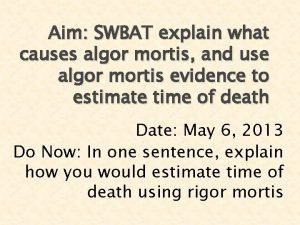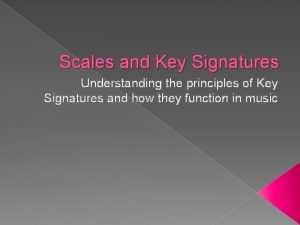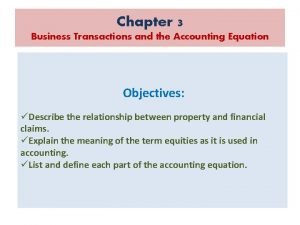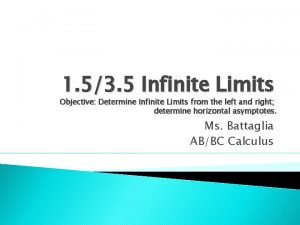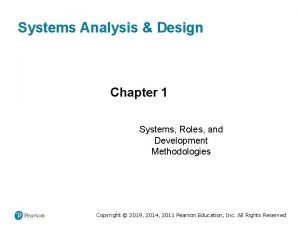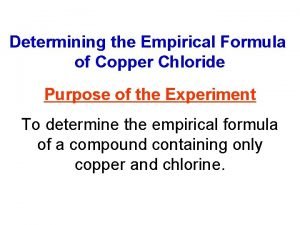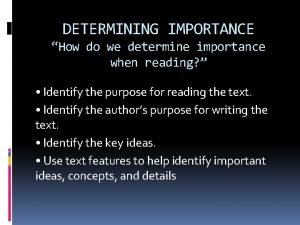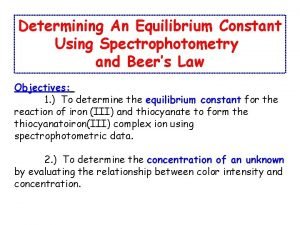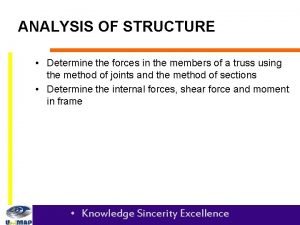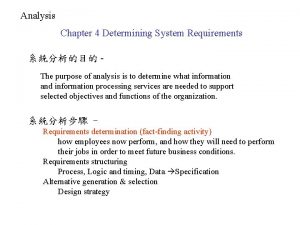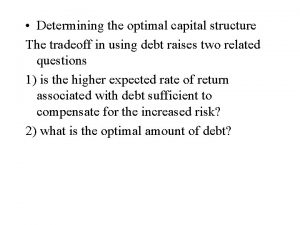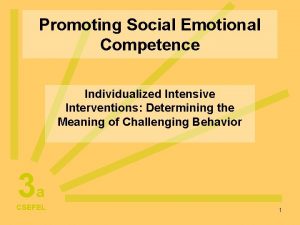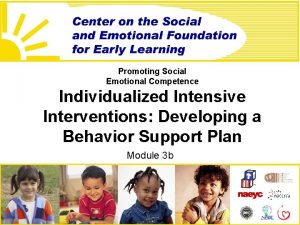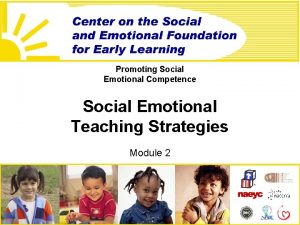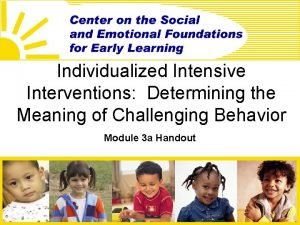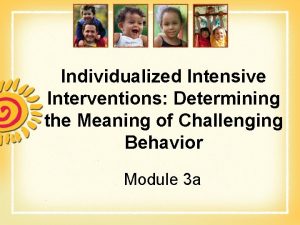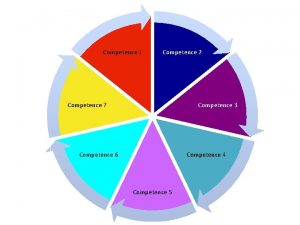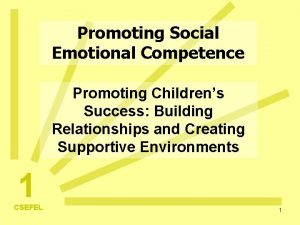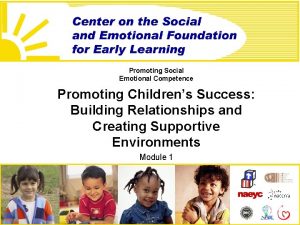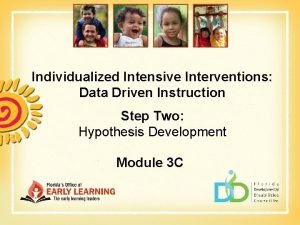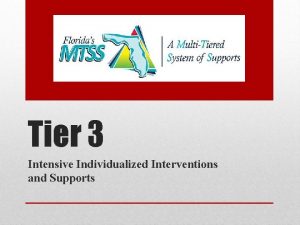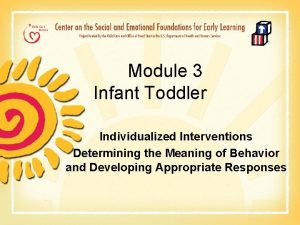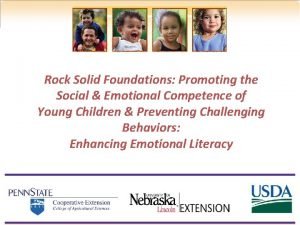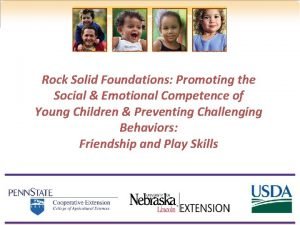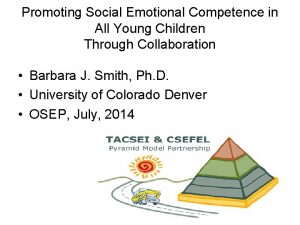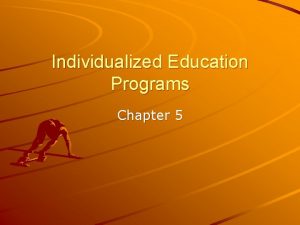Promoting Social Emotional Competence Individualized Intensive Interventions Determining



















































































- Slides: 83

Promoting Social Emotional Competence Individualized Intensive Interventions: Determining the Meaning of Challenging Behavior Module 3 a Handout

Agenda • • • Introduction Challenging Behavior Overview of PBS Behavior Equation The Process of PBS, Building a Team Introduction to Functional Assessment Observation Conducting Observations, Data to Collect Functional Assessment Interview Case Study Activity: Determining the Function Hypothesis Development Not Sure about The Hypothesis

Learner Objectives This workshop will teach you to: 1. 2. 3. 4. Understand the difference between PBS and traditional discipline approaches. Define forms and function of communication and identify the behavioral mechanisms that contribute to viewing challenging behavior as communicative. Identify methods that may be used to determine the function of challenging behavior. Use interview and observation data to determine the communicative function of challenging behavior and develop behavior hypotheses.

Challenging Behavior • What we are referring to when we say • “challenging behavior” is: • Any repeated pattern of behavior that interferes with learning or engagement in pro-social interactions with peers and adults • Behaviors that are not responsive to the use of developmentally appropriate guidance procedures. • Prolonged tantrums, physical and verbal aggression, disruptive vocal and motor behavior (e. g. , screaming, stereotypy), property destructions, self-injury, noncompliance, and withdrawal


The Teaching Pyramid Few children Children at-risk (PBS) Individualized Intensive Interventions Social Emotional Teaching Strategies Designing Supportive Environments All children Building Positive Relationships

Intensive Individualized Interventions Intensive individualized instruction and interventions are used with children who have very persistent and severe challenging behavior and do not respond to the typical preventive practices, child guidance procedures, or social emotional teaching strategies that would normally work with most children.

Group Discussion: Challenging Behavior Challenges • Chart on chart paper

Positive Behavior Support (PBS) • An approach for changing a child’s behavior. • Is based on humanistic values and research. • An approach for developing an understanding of why the child has challenging behavior and teaching the child new skills to replace challenging behavior. • A holistic approach that considers all of the factors that impact on a child, family, and the child’s behavior.

Research on PBS • Effective for all ages of individuals with disabilities 2 -50 years. • Effective for diverse groups of individuals with challenges: mental retardation, oppositional defiant disorder, autism, emotional behavioral disorders, children at risk, etc. • PBS is the only comprehensive and evidence-based approach to address challenging behavior within a variety of natural settings.

Old Way – New Way Old Way • General intervention for all behavior challenges • Intervention is reactive • Focus on behavior reduction • Quick fix New Way • Intervention matched to purpose of the behavior • Intervention is proactive • Focus on teaching new skills • Long-term interventions

Challenging Behavior Communicates May be used to communicate a message when a child does not have language May be used instead of language by a child who has limited social skills or has learned that challenging behavior will result in meeting his or her needs

Challenging Behavior Works • Children engage in challenging behavior because “it works” for them. • Challenging behavior results in the child gaining access to something or someone (i. e. , obtain/request) or avoiding something or someone (i. e. , escape/protest).

Video 3 a. 2: Brendan – Before PBS

Video 3 a. 3: Brendan’s Family – Before PBS

Video 3 a. 4: Brendan’s Family– Before PBS (Cont. )

Video 3 a. 5: Brendan – With PBS

Video 3 a. 6: Brendan’s Family – With PBS

Video 3 a. 7: Tim – Before PBS

Video 3 a. 8: Tim – With PBS

Video 3 a. 9: Importance of PBS

Dimensions of Communication Every communicative behavior can be described by the form and function. • Form: the behavior used to communicate. • Function: the reason or purpose of the communicative behavior.

Children Communicate in Many Ways: • Forms of communication – – – – – Words Sentences Point to a picture Eye gaze Pulling adult Crying Biting Tantrums ?

Children Communicate a Variety of Messages Functions of communication – – – Request object, activity, person Escape demands Escape activity Escape a person Request help Request social interaction Comment Request information Request sensory stimulation Escape sensory stimulation ?

Behavior Equation Trigger Behavior Joey is asked to Joey resists, come to circle. cries, and hits Teacher provides teacher. physical prompt to move him to group. Maintaining Consequence Teacher moves away from Joey and allows Joey to select a different activity.

Setting Event • Event that occurs at another time that increases the likelihood the child will have challenging behavior. Setting events serve to “set the child up” to have challenging behavior.

Behavior Equation Setting Event Trigger Quan approaches computer and sees child working on program. Behavior Quan moves his picture to indicate that he is next. Quan observes and waits for his turn. Maintaining Consequence Child leaves computer and Quan sits down and begins working.

Behavior Equation Setting Event Quan was up most the night with an asthma attack. He arrives at school looking sleepy and with dark circles under his eyes. Trigger Quan approaches computer and sees child working on program. Behavior Quan hits child and pushes his body on the child’s chair. Maintaining Consequence Child leaves computer and Quan sits down and begins working.

Evan • Evan is playing with Duplos. He tries to attach a block to his stack of 3. He can’t quite get the blocks to connect. He looks up at the adult and begins fussing. He holds the stack of blocks up, looks at the blocks, and looks at the adult. The adult helps him put the blocks together.

Evan Setting Event Trigger Behavior Function: Maintaining Consequence

Shana • Shana is sitting in her high chair with nothing on the tray. Her mother is stirring her oatmeal. Shana begins crying and bangs her head on the back of the seat. Her mother says to her, "It's not cool enough, honey; just a minute. " Shana stops crying when the oatmeal is placed on her tray.

Shana Setting Event Trigger Behavior Function: Maintaining Consequence

Gabriella • Gabriella is playing in her room. Her mom says, “Come on Gabriella. Time to go to school. ” Her mom pulls on her arm to try to get Gabriella to stand go to the car. Gabriella yells, screams, and begins kicking at her toys. Her mother says, “All right, 5 more minutes. But then we must go. ” Gabriella’s mom walks away, and Gabriella continues playing with her toys.

Gabriella Setting Event Trigger Behavior Function: Maintaining Consequence

Tim • Tim is riding a trike on the playground bike path. He sees a child move to the sandbox where Tim had just finished building a road-way. He leaps off his trike and tackles the child. He hits the child. An adult comes over to intervene. She comforts the child and scolds Tim goes to the sandbox and continues construction on his road-way.

Tim Setting Event Trigger Behavior Function: Maintaining Consequence

Madison • Madison is in housekeeping, putting on high heels and a hat. Emily moves into the area and selects a purse from the dress-up box. Madison shouts “no” and bites Emily. A teacher comes over; she asks Madison to go to the thinking chair and takes Emily to the bathroom to look at the bite. After 4 minutes, Madison leaves the thinking chair and returns to housekeeping. She grabs the purse Emily had selected and continues to play. Emily leaves the bathroom with the teacher and then begins an art activity where the teacher is present.

Madison Setting Event Trigger Behavior Function: Maintaining Consequence

Process of Positive Behavior Support Step 1: Establishing a collaborative team and identifying goals Step 2: Gathering information (functional assessment) Step 3: Developing hypotheses (best guess) Step 4: Designing behavior support plans Step 5: Implementing, monitoring, evaluating outcomes, and refining plan in natural environments

Potential Team Members • • • Parents/Family Teacher(s) Assisting Teacher/Paraprofessional Therapists Administrative Staff Other(s)

Group Discussion: Welcoming Families • Chart on chart paper

Process of Positive Behavior Support Step 1: Establishing a collaborative team and identifying goals Step 2: Gathering information (functional assessment) Step 3: Developing hypotheses (best guess) Step 4: Designing behavior support plans Step 5: Implementing, monitoring, evaluating outcomes, and refining plan in natural environments

Functional Assessment • A process for developing an understanding of a person’s challenging behavior and, in particular, how the behavior is governed by environmental events. • Results in the identification of the “purpose” or “function” of the challenging behavior.

Functional Assessment • Observe the child in target routines and settings. • Collect data on child behavior, looking for situations that predict challenging behavior and that are linked with appropriate behavior. • Interview persons most familiar with the child. • Review records.

1 2 3 4 5 6 7 8 9 * 0 #

Answer

Observation Card Name: General Context: Social Context: Challenging Behavior: Social Reaction: POSSIBLE FUNCTION: Observer: Date: Time:

Observation Card Example Name: Karen Observer: teacher General Context: Choice time/art Date: 1/22 Time: 10: 00 Social Context: Playing alone in house. Teacher comes over to Karen and asks her to come to the art table for art. When she doesn’t respond, the teacher tries to assist her by taking her arm to nudge her to stand. Challenging Behavior: Karen pulls away and begins to protest by saying, “No! I not go to art!” as she pulls away from the teacher. Social Reaction: The teacher walks away and says, “I will be back in a few minutes to see if you are ready. ” POSSIBLE FUNCTION: Escape art

Video 3 a. 10: Observation Vignette #1

Observation Card Name: Segment 1 Observer: General Context: Choice time Social Context: . Challenging Behavior: Social Reaction: POSSIBLE FUNCTION: Date: Time:

Video 3 a. 11: Observation Vignette #2

Observation Card Name: Segment 2 Observer: General Context: Playground Social Context: Challenging Behavior: Social Reaction: POSSIBLE FUNCTION: Date: Time:

Video 3 a. 12: Observation Vignette #3

Observation Card Name: Segment 3 General Context: Computer Social Context: Challenging Behavior: Social Reaction: POSSIBLE FUNCTION: Observer: Date: Time:

Video 3 a. 13: Observation Vignette #4

Observation Card Name: Segment 4 Observer: General Context: Enter Library Social Context: Challenging Behavior: Social Reaction: POSSIBLE FUNCTION: Date: Time:

Video 3 a. 14: Observation Vignette #5

Observation Card Name: Segment 5 Observer: General Context: Circle with puppet Social Context: . Challenging Behavior: Social Reaction: POSSIBLE FUNCTION: Date: Time:

Video 3 a. 15: Observation Vignette #6

Observation Card Name: Segment 6 Observer: General Context: Center time Social Context: Challenging Behavior: Social Reaction: POSSIBLE FUNCTION: Date: Time:

Sample Setting Event Chart What happened the night before? How was his behavior? MON TUES WED THURS FRI SAT SUN Slept Poorly Yes Yes Yes No No Mom on Midnight Shift Yes Yes No No Tantrum in A. M. Yes Yes No No Tantrum in P. M. Yes Yes No No

Sample Setting Event Chart Mon How does Rides the he come bus to school? Mom brings Tantrum at small group Wed Thurs Fri Tantrum at a. m. circle His Tantrum behavior? at snack Tues

Scatter Plot Student: Observer: Dates: Rachel Maya 10/1 through 10/12 Target Behavior: Hitting Peers Using a scatter plot involves recording the times of day (and/or activities) in which the behavior does and does not occur to identify patterns over days or weeks Behavior did not occur Dates Time 7: 30 Activity 10/1 10/2 10/3 10/4 10/5 10/8 10/9 10/10 10/11 10/12 Behavior did occur Arrival Free Choice 9: 00 Planning 9: 30 Centers 10: 30 Snack 11: 00 Outside 11: 30 Small Group 12: 00 Lunch 12: 30 Nap 1: 30 Outside 2: 30 P. M. Circle 3: 00 Departure NA Did not observe

Activity Analysis Child: Rachel Activity Description Routine/Activity: House Center Behavior Expectations Problems Steps: 1. Select materials 1. Pick materials that no one is using. 2. Pretend in roles 2. Use materials appropriately. 3. Exchange materials with peers 3. Don’t take from peer. 4. Follow peers’ lead or 4. Maintain engagement. accept role assignment 5. Clean-up 5. Put materials on shelf in correct area. 3. Takes materials from others. 4. Ignores peers, interferes in play.

Activity Analysis Child: Rachel Activity Description Routine/Activity: Snack Behavior Expectations Problems Steps: 1. Sit in chair. 1. Stay in seat. 2. Take food from plate when 2. Take one item, wait for passed. turn. 2. Takes multiple items, puts hand in bowl, grabs while plate is passed. 3. Eat food on plate. 3. Eat from own plate. 3. Takes food from other children’s plates. 4. Drink juice from own cup. 4. Drink and put cup on table. 5. Ask for more food. 5. Ask using please. 6. Wipe face with napkin. 6. Use napkin, not clothing. 7. Throw plate/cup/napkin away when finished. 7. Clear place, throw in trash. 5. Grabs food when she wants more.

Everybody Helps • • Family collects data Educational staff collects data Therapists collect data Collect data in ALL settings

“KIS” • “KIS it” (Keep It Simple) - - Create simple, userfriendly forms to collect information (e. g. , rating scales, checklists).

Home Observation Card

Home Observation Card

Functional Assessment Interview • • • Define behavior (describe what you see) Describe frequency and intensity Explore possible setting events Identify predictors (triggers) Identify maintaining consequences Identify current communicative functions Describe efficiency of the behavior Describe previous efforts Identify possible reinforcers

Functional Assessment Interview • Refer to Tim’s Sample Functional Assessment Interview • Tim. FAI. pdf

Large Group Activity: Complete Last Section of Tim’s FAI Distant Setting Event Immediate Antecedent (Trigger) LINK TO ANSWER Problem Behavior Maintaining Function Consequences

Process of Positive Behavior Support Step 1: Establishing a collaborative team and identifying goals Step 2: Gathering information (functional assessment) Step 3: Developing hypotheses (best guess) Step 4: Designing behavior support plans Step 5: Implementing, monitoring, evaluating outcomes, and refining plan in natural environments

Hypotheses Statements • Triggers of the challenging behavior • Description of the challenging behavior • Responses that maintain the challenging behavior • Purpose of the behavior

Tim’s Support Planning Chart- Hypothesis Trigger • Group play: centers and outside play Behavior Maintaining Consequence Verbal aggression (threats), • Peers give up toys/items physical aggression (hit, • Peers leave area push, kick, punch), property • Adults intervene with Function: destruction negative attention on Tim obtain toy/play Setting Events (if applicable): Preventions New Skills New Responses

Hypothesis Statement In group play situations (outside play/centers), Tim uses verbal aggression (threats), physical aggression (hit, push, kick, punch), and property destruction (throwing or banging toys) to obtain toys and/or join play. When this occurs, the peer relinquishes the desired toy and leaves the play area and/or an adult intervenes and provides Tim with excessive negative attention.

Hypothesis Statement Billy will use tantrums to request a social interaction. Billy will initiate a chase game or request to be held by pulling the adult’s hand or positioning the adult. If the adult does not comply, Billy will cry loudly, scream, and bring his hands to his face or ears. Often the adult will comply with his request or pick him up.

Hypothesis Statement Marcia tantrums to escape moving to a new activity. When she is asked to transition from an activity (e. g. , playing in the sandbox) to another activity, she will whine, cry, pretend to vomit, slap at the adult, and scream. When she does this, the adult lets her stay a little longer with the original activity or picks her up kicking and screaming.

Not Sure About the Hypothesis? • What would make the challenging behavior stop? Is it something you would provide or allow the child to access? Or is there something to remove? Or can you allow the child to leave? • If still unsure, collect more data in the same context. • Some challenging behavior may have the same form but serve multiple functions. • Some challenging behaviors may begin around one function (e. g. , escape) and continue to serve another function (e. g. , gain attention).

Working as a Collaborative Team • Assign roles. • Determine agenda and time for meetings. • Ensure group participation through facilitation and participatory processes.

Roles • Facilitator – person who guides group in stating agenda, work goals, time allocation • Recorder – person who writes down the discussion • Time Keeper – Person who tracks time and warns when agenda item is ending • Reporter – person who shares group information, makes presentation • Encourager – person who provides feedback to group members • Jargon-buster – person who asks the question “what do you mean when you say ‘gobbley-gook’ and helps the group with communicating clearly

Hypothesis Development • Assign roles. • Review child description, observation, and interview. • Complete final page of interview. • Determine functions of challenging behavior. • Write hypothesis statement for at least one function. • Report to group.

Major Messages 1. Challenging behavior has meaning for the child. 2. Children use behavior to access something or someone (obtain/request) or avoid something or someone (escape/protest). 3. The process of Functional Assessment is used to determine the function or purpose of challenging behavior. 4. Hypotheses statements describe the triggers, challenging behavior, maintaining consequences, and function.
 Tucker turtle takes time to tuck and think video
Tucker turtle takes time to tuck and think video Peter g schultz
Peter g schultz Individualized consideration
Individualized consideration Is steve jobs a transformational leader
Is steve jobs a transformational leader Individualized instruction vs differentiated instruction
Individualized instruction vs differentiated instruction Individualized education plan
Individualized education plan Irs scale
Irs scale Individualized family service plan example
Individualized family service plan example Center for individualized medicine
Center for individualized medicine Individualized healthcare
Individualized healthcare Promoting moral improvement
Promoting moral improvement Promote service arrange decide
Promote service arrange decide Promoting alternative thinking strategies
Promoting alternative thinking strategies Lesson 4 promoting health and wellness
Lesson 4 promoting health and wellness Promoting family earthquake preparedness
Promoting family earthquake preparedness Chapter 1 understanding health and wellness lesson 4
Chapter 1 understanding health and wellness lesson 4 Promoting racial literacy in schools
Promoting racial literacy in schools Lesson 4 promoting health and wellness
Lesson 4 promoting health and wellness Leaving cert business philip curry
Leaving cert business philip curry Keeping an infant safe and well section 7-3
Keeping an infant safe and well section 7-3 Promoting excellence in dementia care
Promoting excellence in dementia care Deontology ethics
Deontology ethics Chapter 7 promoting health and wellness
Chapter 7 promoting health and wellness Chapter 30 promoting bowel elimination
Chapter 30 promoting bowel elimination Chapter 13 distributing and promoting products
Chapter 13 distributing and promoting products Promoting services and educating customers
Promoting services and educating customers Health promoting schools model
Health promoting schools model Active participation strategies
Active participation strategies Promoting a positive health and safety culture
Promoting a positive health and safety culture Unit 11 safeguarding adults and promoting independence
Unit 11 safeguarding adults and promoting independence National integration and international understanding
National integration and international understanding Institutional support to entrepreneurship
Institutional support to entrepreneurship Health promoting school
Health promoting school Japan's principal asset in promoting development is
Japan's principal asset in promoting development is Health and wellness vocabulary
Health and wellness vocabulary Social thinking and social influence in psychology
Social thinking and social influence in psychology Social thinking social influence social relations
Social thinking social influence social relations Social-emotional assets and resilience scales pdf
Social-emotional assets and resilience scales pdf Social emotional needs of ell students
Social emotional needs of ell students Fictional character names
Fictional character names Social emotional present level of performance examples
Social emotional present level of performance examples Autonomy vs shame and doubt example
Autonomy vs shame and doubt example Emotional resilience in social work
Emotional resilience in social work Social development in middle childhood
Social development in middle childhood Emotional and social development in middle adulthood
Emotional and social development in middle adulthood Emotional development in early adulthood
Emotional development in early adulthood Social emotional learning standards michigan
Social emotional learning standards michigan Preschool learning foundations social emotional
Preschool learning foundations social emotional Second step social emotional skills for early learning
Second step social emotional skills for early learning New jersey social emotional learning standards
New jersey social emotional learning standards Idoe sel
Idoe sel Indiana department of education social emotional learning
Indiana department of education social emotional learning Social and emotional wellbeing framework
Social and emotional wellbeing framework Social emotional learning washington state
Social emotional learning washington state Social emotional learning powerpoint template
Social emotional learning powerpoint template Social emotional observation checklist
Social emotional observation checklist Sefel training
Sefel training Social and emotional development in late adulthood
Social and emotional development in late adulthood Traditional methods for determining requirements
Traditional methods for determining requirements Determining the arrival times between p-wave and s-wave
Determining the arrival times between p-wave and s-wave End group analysis
End group analysis How to determine the rate determining step
How to determine the rate determining step Common critical values
Common critical values Margin of safety ratio formula
Margin of safety ratio formula Oxidation number rukes
Oxidation number rukes Calculating time of death using rigor mortis
Calculating time of death using rigor mortis What is optimal level of product availability
What is optimal level of product availability Kendall and kendall system analysis and design
Kendall and kendall system analysis and design Do not use key signature
Do not use key signature Transport number electrochemistry
Transport number electrochemistry Chardakov method principle
Chardakov method principle Problem 3-2 accounting
Problem 3-2 accounting Limits at infinity definition
Limits at infinity definition Determining human information requirements
Determining human information requirements Teacher twins 2015 answer key
Teacher twins 2015 answer key How to do empirical formula
How to do empirical formula Determine
Determine Determining equilibrium constant using spectrophotometry
Determining equilibrium constant using spectrophotometry Pearson education south asia pte ltd
Pearson education south asia pte ltd Determining system requirements
Determining system requirements Determining comparative advantage output method
Determining comparative advantage output method Personality feasibility
Personality feasibility Determining optimal capital structure
Determining optimal capital structure Hard standards and soft standards examples
Hard standards and soft standards examples
